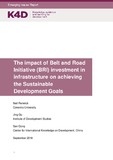| dc.contributor.author | Renwick, Neil | |
| dc.contributor.author | Gu, Jing | |
| dc.contributor.author | Gong, Sen | |
| dc.coverage.spatial | China | en |
| dc.coverage.spatial | Kenya | en |
| dc.coverage.spatial | Ethiopia | en |
| dc.date.accessioned | 2018-10-31T16:50:00Z | |
| dc.date.available | 2018-10-31T16:50:00Z | |
| dc.date.issued | 2018-10-31 | |
| dc.identifier.citation | Renwick, N.; Gu, J. and Gong, S. (2018) The Impact of Belt and Road Initiative (BRI) Investment in Infrastructure on Achieving the Sustainable Development Goals, K4D Emerging Issues Report, Brighton: IDS | en |
| dc.identifier.uri | https://opendocs.ids.ac.uk/opendocs/handle/20.500.12413/14097 | |
| dc.description.abstract | This report addresses a major “emerging issue” and central question: “To what extent does China’s Belt and Road Initiative (BRI) contribute to closing the global ‘infrastructure gap’ and thereby help achieve the Sustainable Development Goals (SDGs) and Agenda 2030?” The Belt and Road Initiative (BRI) has grown from a proposal made by Chinese President Xi Jinping in 2013 and its formal launch in 2015 into a global project encompassing 65 countries across all continents, configured around a series of inter-locking trade and investment corridors. The BRI is intended to act as a primary force for facilitating critical investment to build closer and stronger channels of maritime and continental connections from China to international markets. The BRI concentrates on building greater capacity through infrastructure and prioritises key sectors such as transport, communications and energy. In its conception, the BRI operates through public-private partnerships. These partnerships are intended to harness the requisite financing as well as to provide collaboration on implementing projects.
This report explains critical perspectives on the BRI from an international development perspective. To address this question and central aim, the report has four sections: (i) a summary of the existing English and Chinese literature on key interactions between the BRI and SDGs and infrastructure development; (ii) an evaluation of complementarities and differences between the approaches of the established or orthodox approach to infrastructure development and that of China; (iii) a short case study of Africa, with specific reference to Kenya and Ethiopia; and (iv) an explanation of the policy implications for traditional donors, such as the UK, in partnering with China on BRI investment in infrastructure. | en |
| dc.language.iso | en | en |
| dc.publisher | IDS | en |
| dc.relation.ispartofseries | K4D Emerging Issues Report; | |
| dc.rights | This report was prepared for the UK Government’s Department for International Development (DFID) and its partners in support of pro-poor programmes. It is licensed for non-commercial purposes only. K4D cannot be held responsible for errors or any consequences arising from the use of information contained in this report. Any views and opinions expressed do not necessarily reflect those of DFID, K4D or any other contributing organisation. © DFID - Crown copyright 2018. | en |
| dc.rights.uri | https://www.nationalarchives.gov.uk/doc/open-government-licence/version/3/ | en |
| dc.subject | Economic Development | en |
| dc.subject | Governance | en |
| dc.subject | Trade | en |
| dc.title | The Impact of Belt and Road Initiative (BRI) Investment in Infrastructure on Achieving the Sustainable Development Goals | en |
| dc.title.alternative | | |
| dc.type | Emerging Issues Report | en |
| dc.rights.holder | DFID – Crown Copyright | en |
| rioxxterms.funder | Department for International Development, UK Government | en |
| rioxxterms.identifier.project | K4D | en |
| rioxxterms.version | VoR | en |
| rioxxterms.funder.project | 238a9fa4-fe4a-4380-996b-995f33607ba0 | en |

